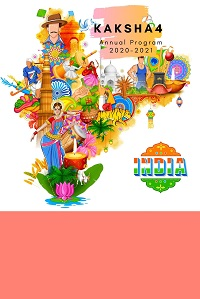Price: $199 (16 Classes, 1.5 Hours per Class) VHS Certificate after successful completion of Annual Program.
Program Name: Kaksha 4 Semester 1
Program Name: Kaksha 4 Semester 1
Mode: Online
Class Duration: 1.5 Hour
Frequency : Once in a weekAge-Group : 9-10 years
Class Schedule:Days |
Monday | Tuesday | Wednesday | Thursday | Friday |
|---|---|---|---|---|---|
| Timing (CST) |
10:00am-11:30am
4:00pm-5:30pm |
11:30am -1:00pm
4:00pm-5:30pm |
1:00pm-2:30pm
5:30pm-7:00pm |
11:30am -1:00pm
5:30pm-7:00pm |
10:00am-11:30pm
5:30pm-7:00pm |
| Start Date | End Date | Fee (USD) | Total Classes | |
|---|---|---|---|---|
| Semester-1 | Aug 2020 | Dec 2020 | $199 | 16 Classes |
| Semester-2 | Jan 2021 | May 2020 | $199 (due in Nov) | 16 Classes |
Proficiency:
-
Reading-
-
Students are able to understand some information from the simplest connected texts dealing with a limited number of personal and social needs, although there may be frequent misunderstandings.
-
Students at this level will be challenged to derive meaning from connected texts of any length.
-
Writing-
-
Students at the Intermediate Low sublevel are able to meet some limited practical writing needs
-
They can create statements and formulate questions based on familiar material
-
Most sentences are recombinations of learned vocabulary and structures.
-
These are short and simple conversational-style sentences with basic word order.
-
They are written almost exclusively in present time.
-
Writing tends to consist of a few simple sentences, often with repetitive structure.
-
Topics are tied to highly predictable content areas and personal information.
-
Vocabulary is adequate to express elementary needs.
-
There may be basic errors in grammar, word choice, punctuation, spelling, and in the formation and use of non- alphabetic symbols.
-
Their writing is understood by natives used to the writing of non-natives, although additional effort may be required.
-
When Intermediate Low writers attempt to perform writing tasks at the Advanced level, their writing will deteriorate significantly and their message may be left incomplete.
Speaking-
Students at the Intermediate Low sublevel are able to successfully handle a limited number of uncomplicated communicative tasks by creating with the language in straightforward social situations.
Conversation is restricted to some of the concrete exchanges and predictable topics necessary for survival in the target-language culture.
These topics relate to basic personal information; for example, self and family, some daily activities and personal preferences, and some immediate needs, such as ordering food and making simple purchases.
At the Intermediate Low sublevel, students are primarily reactive and struggle to answer direct questions or requests for information.
They are also able to ask a few appropriate questions.
Intermediate Low speakers manage to sustain the functions of the Intermediate level, although just barely.
Intermediate Low speakers express personal meaning by combining and recombining what they know and what they hear from their interlocutors into short statements and discrete sentences.
Their speech is characterized by frequent pauses, ineffective reformulations and self- corrections.
Their pronunciation vocabulary, and syntax are strongly influenced by their first language.
In spite of frequent misunderstandings that may require repetition or rephrasing, Intermediate Low speakers can generally be understood by sympathetic interlocutors, particularly by those accustomed to dealing with non-natives.
Listening-
At the Intermediate Low sublevel, students are able to understand some information from sentence- length speech, one utterance at a time, in basic personal and social contexts, though comprehension is often uneven.
At the Intermediate Low sublevel, listeners show little or no comprehension of oral texts typically understood by Advanced- level listeners
* This Program has two Semesters.
